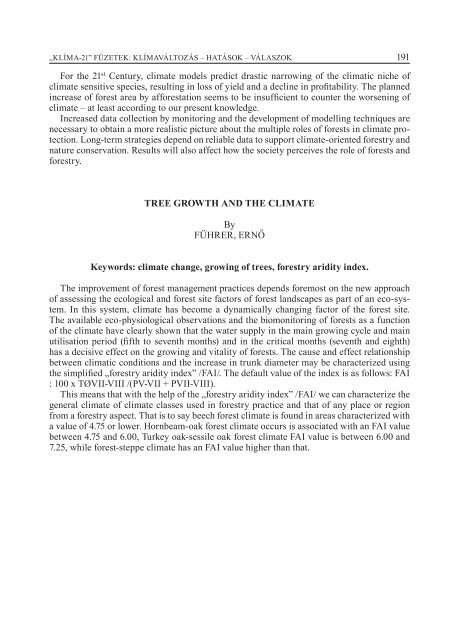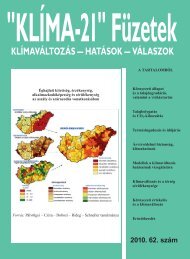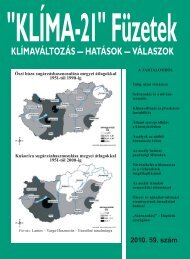KLÃMA-21 Füzetek 61. szám - VAHAVA Hálózat
KLÃMA-21 Füzetek 61. szám - VAHAVA Hálózat
KLÃMA-21 Füzetek 61. szám - VAHAVA Hálózat
Create successful ePaper yourself
Turn your PDF publications into a flip-book with our unique Google optimized e-Paper software.
„KLÍMA-<strong>21</strong>” FÜZETEK: KLÍMAVÁLTOZÁS – HATÁSOK – VÁLASZOK 191<br />
For the <strong>21</strong> st Century, climate models predict drastic narrowing of the climatic niche of<br />
climate sensitive species, resulting in loss of yield and a decline in profitability. The planned<br />
increase of forest area by afforestation seems to be insufficient to counter the worsening of<br />
climate – at least according to our present knowledge.<br />
Increased data collection by monitoring and the development of modelling techniques are<br />
necessary to obtain a more realistic picture about the multiple roles of forests in climate protection.<br />
Long-term strategies depend on reliable data to support climate-oriented forestry and<br />
nature conservation. Results will also affect how the society perceives the role of forests and<br />
forestry.<br />
TREE GROWTH AND THE CLIMATE<br />
By<br />
FÜHRER, ERNŐ<br />
Keywords: climate change, growing of trees, forestry aridity index.<br />
The improvement of forest management practices depends foremost on the new approach<br />
of assessing the ecological and forest site factors of forest landscapes as part of an eco-system.<br />
In this system, climate has become a dynamically changing factor of the forest site.<br />
The available eco-physiological observations and the biomonitoring of forests as a function<br />
of the climate have clearly shown that the water supply in the main growing cycle and main<br />
utilisation period (fifth to seventh months) and in the critical months (seventh and eighth)<br />
has a decisive effect on the growing and vitality of forests. The cause and effect relationship<br />
between climatic conditions and the increase in trunk diameter may be characterized using<br />
the simplified „forestry aridity index” /FAI/. The default value of the index is as follows: FAI<br />
: 100 x TØVII-VIII /(PV-VII + PVII-VIII).<br />
This means that with the help of the „forestry aridity index” /FAI/ we can characterize the<br />
general climate of climate classes used in forestry practice and that of any place or region<br />
from a forestry aspect. That is to say beech forest climate is found in areas characterized with<br />
a value of 4.75 or lower. Hornbeam-oak forest climate occurs is associated with an FAI value<br />
between 4.75 and 6.00, Turkey oak-sessile oak forest climate FAI value is between 6.00 and<br />
7.25, while forest-steppe climate has an FAI value higher than that.






